Babo Botanicals Clear Zinc Sunscreen
- 16 percent zinc oxide solution
- Water resistant for 80 minutes
- Reapply at least every two hours or after 80 minutes of swimming

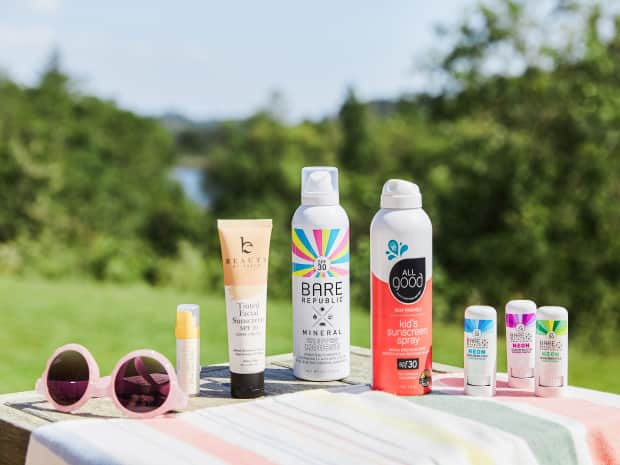
Last Updated: August 2, 2021
Have you seen the news of sunscreen recalls? Thinking of switching to natural sunscreen? Read this real review of making the switch to see how natural mineral sunscreen works. Grove writer Kristen Bailey decided to switch to see if mineral and zinc oxide sunscreens actually work.
Back in the good ol’ ‘70s and ‘80s, when child restraints in cars were optional, my sister and I spent a lot of time “laying out.” We’d break out the polka-dot quilt, turn up the boom box, and positively slather our bodies from head to toe with Johnson’s Baby Oil, because back then, literally baking petrochemicals into your skin was deemed perfectly safe.
Well. Time, she do fly, and with her, our blissful, willful ignorance. Is there a single soul out there who doesn’t know that the sun’s powerful cosmic space rays do catastrophic damage to human DNA?
We all know the importance of sun protection, and it’s also pretty well known that chemical sunscreens have less-than-desirable ingredients. So I decided to give natural mineral sunscreen with zinc oxide a try to see how it works.

Only two of the 16 active ingredients approved by the Food and Drug Administration for use in sunscreens are generally recognized as safe and effective (GRASE). Both of these ingredients are minerals — zinc oxide and titanium dioxide — that sit on top of your skin to create a physical barrier against UVA and UVB rays.
Zinc oxide is a mild astringent with weak antiseptic properties. When it’s applied to the skin, it forms a barrier that protects against irritants, moisture, and the harmful rays of the sun. Zinc oxide is the active ingredient in diaper rash cream and some first aid ointments that treat minor burns, cuts, scrapes, and insect bites.
Titanium dioxide is a white powder that’s used as a pigment in paint, inks, and a slew of other industrial products. It’s also a common ingredient in cosmetics, soap, toothpaste — and sunscreen. Titanium dioxide has spectacular light-scattering properties, and it deflects UV rays away from the body so they don’t reach your skin.
If you have a choice, mineral sunscreen is your best bet for the safest possible skin protection. Mineral sunscreen is non-toxic, non-irritating, hypoallergenic, and naturally water-resistant. Plus, mineral sunscreens are best for children under 2 and anyone with allergies to chemical sunscreens.
You can’t say that about any other FDA-approved sunscreen ingredient — at least, not since 2019, when the FDA raised alarms about some of the most commonly used chemicals in conventional sunscreens, which were found to penetrate the skin and enter the bloodstream.
These dubious suspects have ingredients lists that include avobenzone, oxybenzone, octocrylene, and ecamsule. Some chemical sunscreen ingredients are also devastating to coral reefs.
But, if you’re in a bind, any type of sunscreen on the market is better for your skin — and your health— than radioactive starlight (i.e., the sun rays that include UVA and UVB).

The best sunscreen of any type:
GROVE TIP
An effective mineral sunscreen will contain a zinc oxide and/or titanium dioxide concentration of at least 10 percent, but no higher than 25 percent.
Many folks under-apply mineral sunscreens, because of the white hue it leaves on the skin. Here are some tips to apply zinc oxide sunscreen correctly:
From your face: Use an oil-based cleanser to remove mineral sunscreen from your face, or massage a little coconut oil, olive oil, or any facial oil all over your visage.
Let it soak in for a couple of minutes, then hold a warm, wet washcloth over your face for about 10 seconds. The sunscreen should wipe away easily.
From your body: Take a warm shower, and lather up with a natural soap — Dr. Bronner’s works great! — and gently scrub away the mineral sunscreen with a body glove or loofah.
GROVE TIP
Get some zinc sunscreen on your clothes? Not a problem. Scrape off any excess, sprinkle some baking soda over the stain, and let it sit for 24 hours.
Brush off the baking soda, spritz on some natural stain remover, and leave it overnight. Wash as usual with natural detergent and a little oxy-based, natural non-bleach bleach, and let the garment air dry.
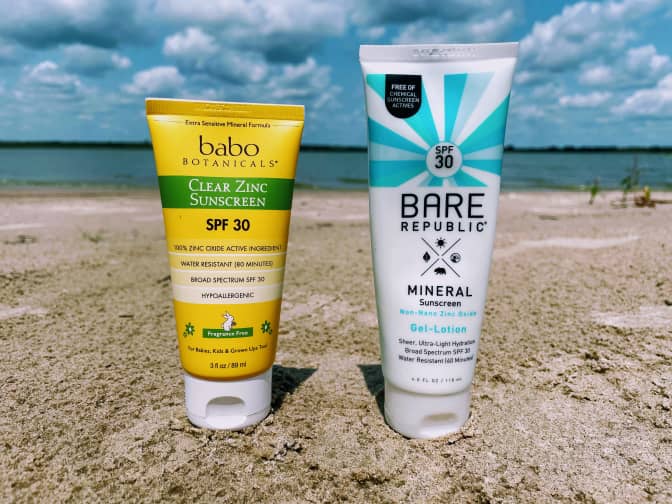
My conventional 30 SPF sunscreen has an “active photobarrier complex” and is made with natural soy, vitamins A, C, and E. Sounds lovely, yeah? Well, flip over the bottle, and you see the active ingredients are avobenzone, homosalate, octisalate, octocrylene, and oxybenzone. Zoinks!
To make the switch from my chemical sunscreen, I tried two mineral-based brands from Grove. Both are 100 percent non-nano zinc oxide formulas, and they’re both hypoallergenic, vegan, reef-safe, and fragrance- and cruelty-free. Both offer broad-spectrum SPF 30 protection.
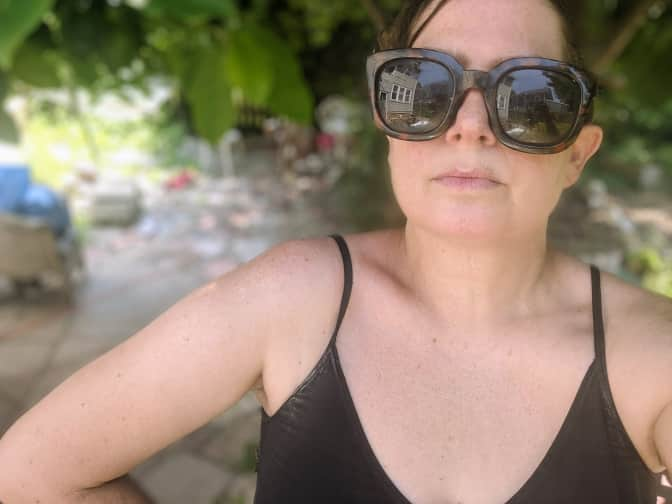
Look at me, all cool as a cucumber before starting an 80-minute yardwork marathon in the full sun on a 94-degree day! I slathered the Babo on the right side of my chest and shoulder and left my left side unprotected (just this once.)

Hot, dirty, and tired! The Babo mineral sunscreen (my right side) held up pretty well compared to no protection, but I definitely got some sun.
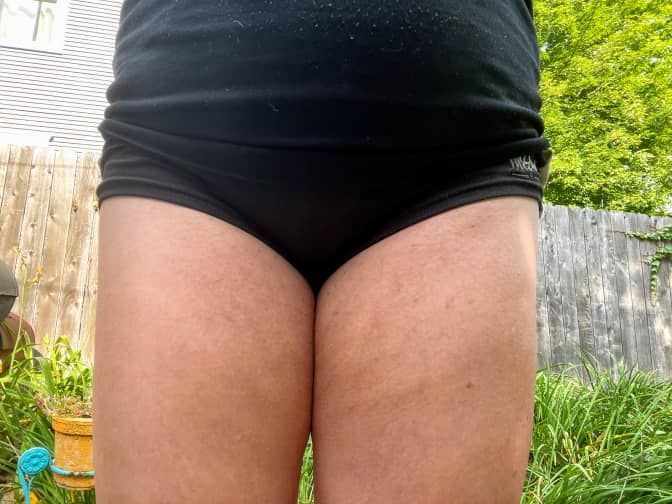
Although my calves, knees, and a few inches above my knees don’t usually sunburn, I often get a little red on my upper legs. So I slathered Bare Republic zinc oxide sunscreen on my left leg and my conventional sunscreen on my right leg, and commenced pulling weeds.
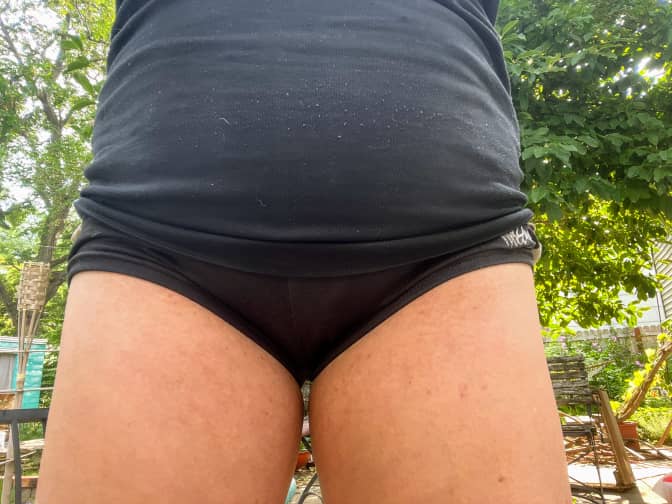
Can you tell the difference? Neither can I. Good job, Bare Republic!
Side note: Notice the pills on my shirt? Here’s how to take care of that nonsense.
The sun doesn’t treat my neighbor Amanda’s skin with kindness. When I get over exposed to the Big Star, it’s a slow, deep burn, like a hot stone massage. Her bright pink burns sting like hell and blister and peel. So I thought I’d see if she wanted to willfully burn for the sake of fair and balanced news. She’s a trooper, so of course she agreed.
We generously coated her right shoulder with Bare Republic and the left with her go-to conventional SPF 30. The unprotected control is the back of her neck. See? A real trooper!
She power washed the deck, hauled some weeds and brush, and after an hour reported that both shoulders felt fine. A half-hour later, she took that back and called it a day. After a shower, she reported back for photos.
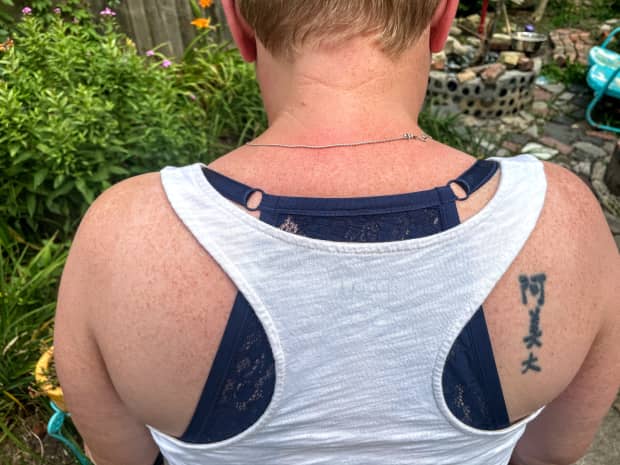
Bare Republic on the right and chemical sunscreen on the left. Nothin’ in the middle — ouch!

Her right shoulder took a heavier sun beating than the left.

The conventional sunscreen performed better than the mineral sunscreen.
If you lean toward stingy, pink burns, I might recommend Bare Republic SPF 50 with 7.8% zinc oxide and 2.9% titanium dioxide. And maybe reapply it every hour instead of every two hours.
But I’m no expert, so…

Wondering who Grove is, what types of products we offer, and how to get a free gift set when you sign up? Learn more about flexible monthly shipments, customizing your shipment, and joining millions of happy households — no monthly fees or commitments required.
Certain kinds of sunscreen react with the rays of the sun when they come into contact with water to create hydrogen peroxide, which is toxic to aquatic plants, like phytoplankton and coral reefs, that provide essential nutrition to marine animals like small fish, dolphins, and whales.
Oxybenzone is one of the 10 sunscreen chemical ingredients responsible for damaging the DNA of corals, bleaching corals, and disrupting coral reproduction.
According to the Environmental Working Group, mineral sunscreens containing zinc oxide and titanium dioxide provide strong sun protection since they don’t readily break down in the sun, and they’re associated with very few health concerns.
But nano-sized versions of these minerals is a different story. While studies show no evidence that nanoparticles cross the skin in large amounts, inhaling or ingesting them can cause lung and gastrointestinal damage.
And nanotechnology in sunscreen isn’t good for coral reefs, either. Nanotechnology involves breaking down and manipulating the particles in these minerals at a molecular and atomic level. While nanoparticles absorb into the skin without leaving white residue behind — which is why consumers like nano mineral sunscreens — they accumulate in coral reef ecosystems and cause damage just like their chemical counterparts.
The FDA requires that all sunscreens remain fully effective for three years. Mineral sunscreens are more stable than chemical sunscreens and usually have a longer shelf life. If you store it in a cool, dark place it will last as long as possible.
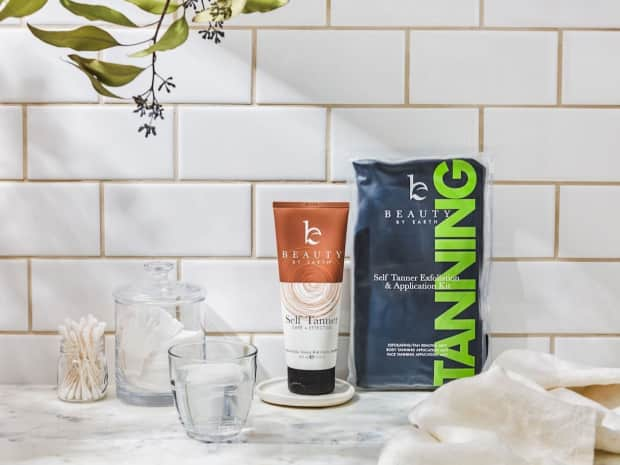
Tips for applying self-tanner, how to make your tan last, and tanning mistakes to avoid.

We've pulled the top 16 natural sunscreens as determined by Grove members.

Wondering which sunscreen SPF number is right for you? Follow along for expert advice.

We've pulled the top 6 bronzers as determined by Grove members.